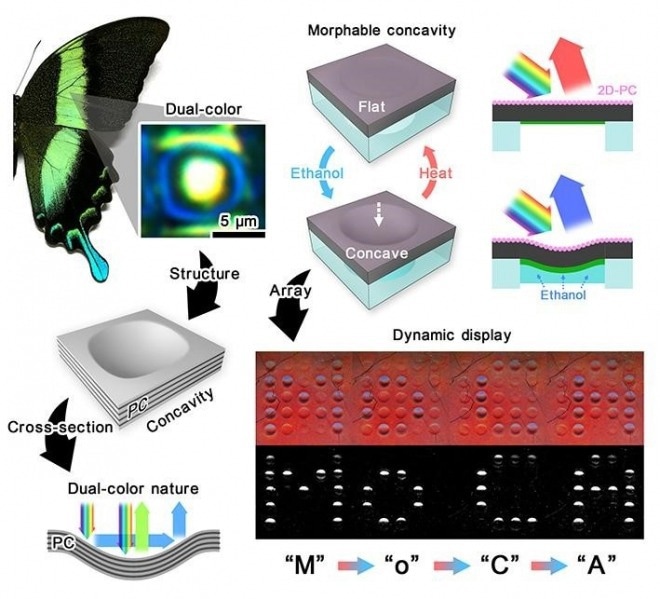A groundbreaking pixelated soft color-changing system referred to as Morphable Concavity Array (MoCA) has been developed by scientists at the University of Hong Kong (HKU).
 (MoCA): A pixelated color-changing soft system that mimics the color-changing structure of a butterfly wing. Image Credit: Hong Kong University.
(MoCA): A pixelated color-changing soft system that mimics the color-changing structure of a butterfly wing. Image Credit: Hong Kong University.
Pixelated soft color-changing systems are flexible structures capable of altering their color by manipulating light. These versatile systems find applications across various industries, including medical devices like bandages that change color in the presence of infection.
They are also used in foldable screens for smartphones and tablets, as well as in wearable technology, where sensors are seamlessly integrated into clothing fabrics.
The study was co-directed by Professor Anderson Ho Cheung Shum from the Department of Mechanical Engineering at HKU, and Professor Mingzhu Li from the Institute of Chemistry, Chinese Academy of Sciences, and headed by Dr. Yi Pan from the Department of Mechanical Engineering at HKU.
The MoCA designed by the HKU researchers is a thin (its thickness is around 3 human hairs) rubber-like structure that comprises two layers – the top layer is a photonic crystal elastomer actuator (PC-EA) film and the bottom one is a hole array –a lattice with evenly spaced round holes.
The PC-EA film itself comprises two layers – a hydrogel layer (pNIPAM) below and an elastomer layer (GPDMS) on top.
If ethanol has been added to the pNIPAM layer, it swells, and the consequent tension pulls the elastomer GPDMS layer downwards into the hole in the array. This produces a dish-like concave shape known as morphable concavity (MoC) that acts as a pixel.
Following the formation of the concavity, the red light is blocked and the visible color of the pixel varies from red to blue.
MoCA draws its inspiration from the intricate structures found on butterfly wings known as dual-color micro-concavities.
Dual-color micro-concavities are considered to be tiny pits that block few wavelengths of light, thereby producing two various colors based on the angle of light and the viewer’s standpoint. On butterfly wings, these pits have been arranged into an even structure called photonic crystals.
MoCA reproduces the photonic crystal of the butterfly wing and is revolutionary as the first instance of a pixelated color-changing system that depends on flat and concave structures to produce various colors.
The color-changing strategy of MoCA is achieved by changing its local morphology, specifically by controlling the transition between ‘flat’ and ‘concave’ states. This sets MoCA apart from other pixelated color-changing systems.
Dr. Yi Pan, Department of Mechanical Engineering, Hong Kong University
Another significant breakthrough with MoCA technology is the ability to manipulate the color changes in individual pixels independently. This is possible because each pixel in MoCA is linked to an individual “piping system” through which ethanol is delivered, allowing for precise and individual control over color changes.
We use multi-channel microfluidics to introduce and remove solvents to manipulate MoCA, offering a complementary approach to the conventional electrochromic methods.
Dr. Yi Pan, Department of Mechanical Engineering, Hong Kong University
MoCA could be utilized for counterfeiting in products, but the HKU team’s long-term goal is to utilize the principles behind MoCA– microfluidics and soft matter, to build optical devices that mimic, and exceed the abilities of the compound eyes of insects.
Compound eyes consist of several light-processing structures and provide numerous benefits over non-compound vision, like an extensive field of vision and the potential to focus on multiple objects simultaneously.
Deformation of the crystalline lens in the human eye enables one to concentrate on different distances, describes Professor Shum. MoCA’s technology, where individual units could be subjected to deformation-made change shape from flat to concave, could be utilized to make several lenses that could alter focus separately.
Crystalline lenses have their benefits, such as higher resolution, greater focusing ability, and better color perception.
Optical devices with a combination of the compound eye and the crystalline lens, would not only imitate nature but transcend it.
Anderson Ho Cheung Shum, Professor, Department of Mechanical Engineering, Hong Kong University
Journal Reference:
Pan, Y., et al. (2023) Pixelating Responsive Structural Color via a Bioinspired Morphable Concavity Array (MoCA) Composed of 2D Photonic Crystal Elastomer Actuators. Advanced Science. doi.org/10.1002/advs.202300347.